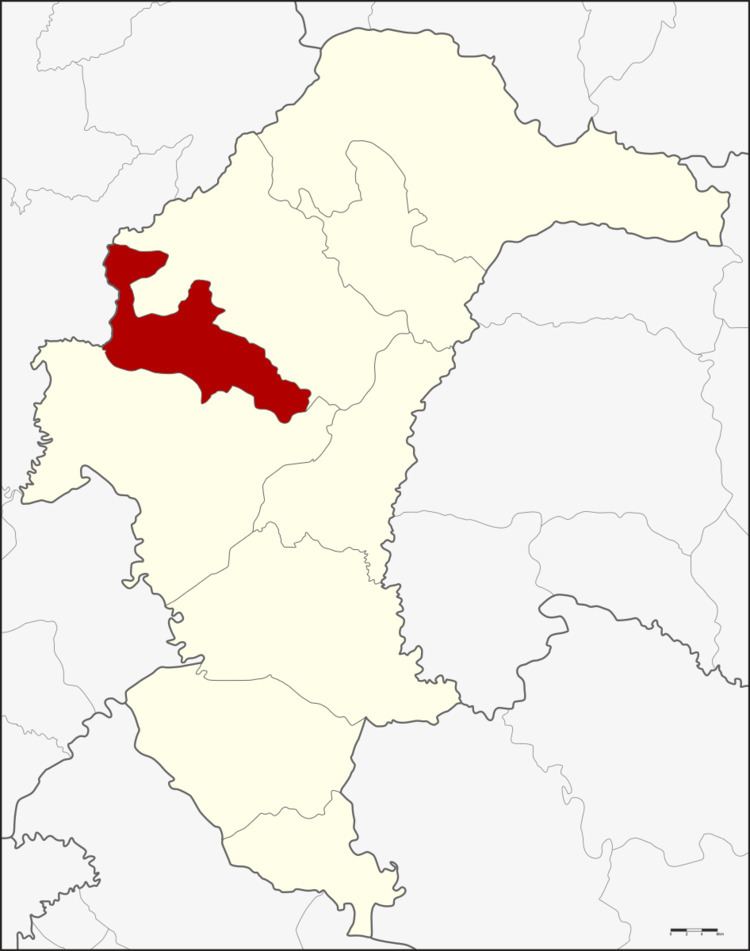Country Thailand Time zone THA (UTC+7) Area 272.8 km² Province Yasothon Province | Seat Sai Mun Postal code 35170 Population 31,092 (2005) Geocode 3502 | |
 | ||
Sai Mun (Thai: ทรายมูล, [sāːj mūːn]) is a district of Yasothon Province in northeastern Thailand.
Contents
- Map of Sai Mun District Yasothon Thailand
- History
- Geography
- Primary occupations
- Secondary occupations
- Important products
- Administration
- District office
- District officers
- Primary schools
- Secondary schools
- Religion
- References
Map of Sai Mun District, Yasothon, Thailand
History
Sai Mun village was formerly a village of Amphoe Yasothon, when it was still part of Ubon Ratchathani Province. The village changed locations around the time of King Rama V when an epidemic caused villagers to abandon their homes and start a new village two kilometers away. At the site of their new village, which is present-day Sai Mun village, the villagers brought sand and soil from various sacred and revered places, and scattered it around the perimeter of their new home, to drive off the epidemic. It was from this ceremony that the village received its name.
Later, Sai Mun was given tambon status, and in 1968, Sanitary District (khet sukhaphiban) Sai Mun was created.
After the separation of Yasothon from Ubon in 1972, on May 15, 1975, Sai Mun was elevated to a minor district (king amphoe), taking four tambon from Amphoe Mueang Yasothon: Sai Mun, Du Lat, Dong Mafai and Na Wiang.
In 1978, tambon Phai was reassigned from Amphoe Kut Chum to King Amphoe Sai Mun.
On July 26, 1984, the minor district was elevated to a district, and May 25, 1999 Sanitary District Sai Mun was elevated to township (thesaban tambon) status.
Geography
Neighboring districts are (from the northeast clockwise) Kut Chum and Mueang Yasothon of Yasothon Province, and Selaphum of Roi Et Province.
Primary occupations
Secondary occupations
Important products
Administration
The district is subdivided into 5 subdistricts (tambon), which comprise 53 villages (muban).
District office
The Sai Mun District Office is located at:
Sukhaphiban 1 Road
Moo 16
T. Sai Mun
A. Sai Mun
Yasothon 35170
District officers
Those who have served as District Officer (nai amphoe) of Sai Mun are:
- Mr. Jadet Musikkawong (นายเจด็จ มุสิกวงศ์), July 27, 1984 - October 4, 1985
- Mr. Prawit Angsunak (นายประวิตร อังศุนาค), October 7, 1985 - October 15, 1987
- Mr. Noppadon Saosung (นายนพปฎล เสาสูง), October 16, 1987 - October 16, 1989
- Mr. Thianchai Bunphet (นายเธียรชัย บุญเพชร), October 24, 1989 - October 9, 1992
- Mr. Chiwit Kaeowatthana (นายชีวิต แก้ววัฒนะ), October 12, 1992 - November 5, 1993
- Mr. Sawang Aksonsiri (นายสว่าง อักษรศิริ), November 8, 1993 - July 1, 1994
- Mr. Kong Bunpradap (นายก้อง บุญประดับ), July 4, 1994 - September 30, 1995
- Mr. Somyot Charoensiri (นายสมยศ เจริญศิริ), November 1, 1995 - November 21, 1999
- Mr. Pramuan Rattanasukhon (นายประมวล รัตนสุคนธ์), November 29, 1999 - September 30, 2002
- Mr. Wirawat Wongwongwai (นายวีระวัฒน์ วงศ์ว่องไว), December 23, 2002 - October 31, 2004
- Mr. Natthaphat Suwanprathip (นายณัฐภัทร สุวรรณประทีป), November 1, 2004 – Present
Primary schools
As of 2003, Amphoe Sai Mun had 25 primary schools with 2,737 students.
Secondary schools
As of 2003, Amphoe Sai Mun had 2 secondary schools with 1,724 students:
Religion
Amphoe Sai Mun is predominantly Buddhist, and is home to 34 wat, with 145 monks and 134 novices.
